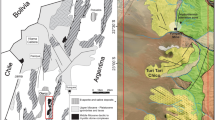Abstract
Igneous formations associated with massive sulphide deposits in the Iberian Pyrite Belt (IPB) are essentially composed of basic lavas and dolerites, and dacitic to rhyolitic volcanites; intermediate lavas are subordinate. The basic rocks show variable geochemical characteristics: lavas and dolerites comparable to recent within-plate alkaline basalts seem restricted to the western and southern parts of the IPB, whereas basic rocks comparable to continental tholeiites or arc-related basalts occur across the whole belt. The felsic rocks are classified as calc-alkaline and belong to the “low-Al2O3 and high-Yb type”. At given SiO2, Al2O3 and TiO2 contents, they show variable Zr, Nb, and HREE contents. Heavy-rare-earth element fractionation decreases from the dacites to the rhyolites ([Gd/Yb]N ∼ 1), whereas the negative Eu-anomaly becomes more pronounced. The characteristics of the rhyolites are typical of sulphide-fertile volcanic packages. Trace-element modelling suggests that the felsic rocks evolved from a dacitic parent magma through fractional crystallization of hornblende and plagioclase. Partial melting of an amphibolite protolith, which appears as the most probable model for the origin of this dacitic magma, requires a high T/P gradient in the crust. The occurrence of alkaline basalts and continental tholeiites is consistent with formation of the IPB in a tensional tectonic setting. However, the associated island-arc tholeiites suggest a location in a domain of plate convergence. Emplacement in a fore-arc basin over a recently accreted crustal segment is envisaged as a possible hypothesis to account for the geological and petrological constraints. A high geothermal gradient and eruption in a submarine tensional basin could have been two key ingredients for the development of massive sulphide deposits within the IPB.
Resumen
(translated by E. Pascual) Las formaciones ígneas asociadas con los depósitos de sulfuros masivos de la Faja Pirítica Ibérica (IPB) se componen esencialmente de doleritas y lavas básicas y de rocas volcánicas dacíticas a riolíticas; las lavas intermedias son poco abundantes. Las rocas básicas muestran caracteres geoquímicos variables: lavas y doleritas comparables a basaltos alcalinos intraplaca recientes parecen hasta ahora restringidos a las partes W y S de la IPB, mientras que rocas básicas de caracteres comparables a las de toleítas continentales o basaltos relacionados con arcos aparecen en toda la zona. Las rocas ácidas se clasifican como calcoalcalinas del tipo “low-Al2O3, high-Yb”. Para un contenido dado en SiO2, Al2O3 y TiO2, muestran contenidos variables en Zr, Nb y REE. El contenido en tierras raras pesadas decrece de dacitas a riolitas ([Gd/Yb]N ∼ 1), al tiempo que la anomalía de Eu se hace más pronunciada. La modelización de elementos trazas sugiere que las rocas evolucionaron a partir de un magma parental dacítico mediante cristalización fraccionada de hornblenda y plagioclasa. La fusión parcial de un protolito anfibolítico, que parece el modelo más plausible para el origen del magma dacítico, requiere un elevado gradiente T/P en la corteza. La existencia de basaltos alcalinos y de toleítas continentales es congruente con la formación de la IPB en un entorno tectónico distensivo. El emplazamiento en una cuenca “fore-arc”, en un segmento cortical de reciente acreción, se contempla como una hipótesis posible para explicar los caracteres geológicos y petrológicos. Un alto gradiente térmico, junto con la erupción en una cuenca submarina extensional, pueden haber sido los dos ingredientes clave en el desarrollo de los depósitos de sulfuros masivos en la IPB.
Similar content being viewed by others
Author information
Authors and Affiliations
Additional information
Received: 3 March 1996 / Accepted: 7 April 1997
Rights and permissions
About this article
Cite this article
Thiéblemont, D., Pascual, E. & Stein, G. Magmatism in the Iberian Pyrite Belt: petrological constraints on a metallogenic model. Mineral. Deposita 33, 98–110 (1997). https://doi.org/10.1007/s001260050135
Issue Date:
DOI: https://doi.org/10.1007/s001260050135



